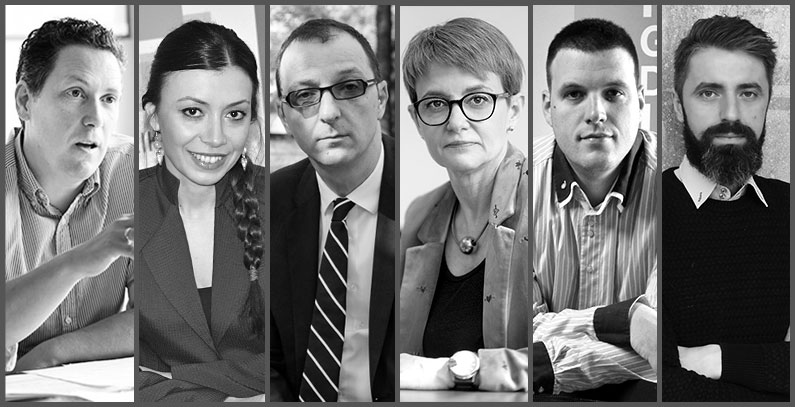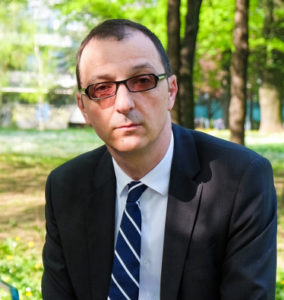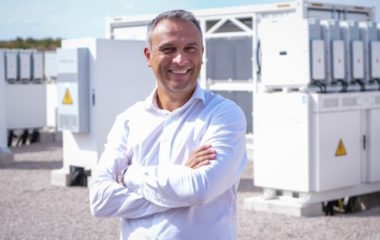
Foto: BGEN
In the third in a series of interviews on waste management with representatives of state institutions, the business community, academia, and civil society in Serbia, we asked what the future of the recycling industry in Serbia, while we also sought positions on the use of waste-derived alternative fuels and the implications for the environment and public health.
The answers were provided by Ivan Karić, a state secretary at the Ministry of Environmental Protection, Igor Jezdimirović, president of the Environment Engineering Group, Aleksandar Jovović, a professor at the Faculty of Mechanical Engineering of the Belgrade University, Dejana Milinković, director of the Association of the Cement Industry of Serbia (CIS), and Suzana Obradović, secretary general of the Recyclers Association of Serbia.
The series of interviews was preceded by the introductory article about the problems, challenges, and possible solutions concerning waste management in Serbia. In the first interview, we asked what needs to be done in the period until Serbia’s accession to the EU, or until 2025; whether the proposed 11-year transitional period from the moment of accession would be sufficient to achieve goals; and how important the establishment of waste separation at source is. In the second interview, we discussed challenges in municipal waste management in Serbia.
BGEN: The recycling industry is currently financed with state subsidies. What are the projections for the recycling industry in the next 10 years and do you see the establishment of a market for recyclates as a possible solution?
Ivan Karić, State Secretary, the Ministry of Environmental Protection
 As part of the Serbian state budget planning for the period ahead, the Ministry of Environmental Protection has envisaged appropriate funds to support the recycling industry, which has been developing with the help of subsidies since 2020. So far, over RSD 15 billion has been set aside for the recycling industry, in the form of subsidies and incentives, and you have to admit these are significant funds. Even though we are not satisfied with the rate of waste recycling, we expect new recycling facilities to be opened in the period ahead, especially for the types of waste that are not yet processed in Serbia.
As part of the Serbian state budget planning for the period ahead, the Ministry of Environmental Protection has envisaged appropriate funds to support the recycling industry, which has been developing with the help of subsidies since 2020. So far, over RSD 15 billion has been set aside for the recycling industry, in the form of subsidies and incentives, and you have to admit these are significant funds. Even though we are not satisfied with the rate of waste recycling, we expect new recycling facilities to be opened in the period ahead, especially for the types of waste that are not yet processed in Serbia.
The waste management system covers not only the recycling industry, but also the waste collection network (public utility companies, private companies, individuals, etc.), which, under the existing regulations, do not receive incentives. At the same time, producers – those subject to the fee payment (extended producer responsibility promoted by the EU) also have to assume part of the waste management responsibility. For the time being, their responsibility ends with the fee payment.
A redesign of the financing and management of the specific waste stream system is possible in the period ahead. As a state, we have committed to meeting all standards under the EU acquis as part of the EU association process. Due to the need to transpose EU regulations and directives regulating the introduction and implementation of the extended producer responsibility (EPR) model, as well as Producer Responsibility Organizations (or their registration) to organize and finance the management of specific waste streams in order to achieve recycling targets set under the EU directives. This means that producers that place products on the market are responsible for their end-of-life management and recovery. It seems to me that a large number of companies is ready to assume the responsibility under the EPR for their products’ end-of-life management.
This approach helps improve the control of fee payment (producers control each other when associated into a Producer Responsibility Organization); lower fees directly result in the number of fee payers; the impact on the growth of retail prices and inflation is low; lower product prices mean stronger production, which is shoring up other budget revenues; the grey economy is reduced; funds are secured to finance other environmental projects; new jobs are created and indirect employment increased (from 1,000 in the first year to 3,000-5,000 in the years to follow); business is secured for other sectors (transport, public companies, …); the business environment and the investment climate are improved; and investments are secured for public utility companies, as are the inclusion of minority and vulnerable groups and a healthier and safer environment.
I believe that tire, electrical and electronic, and packaging waste recyclers are close to commercial operations
In other words, this means we should bring order to “our own backyard,” which will also enable us to meet the tight requirements in the EU accession process. The new Law on Fees will additionally improve the existing system. In order to make possible changes to the system, in line with the EU legislation and our needs, a detailed analysis of the effects of the existing model, as well as the future model, is needed.
At this moment, it seems to me that the state must continue providing support for certain types of waste, as this does not concern only commercialization, but also environmental protection. Until the collection network and the recycling industry are strong enough, we cannot speak with certainty of the industry’s market-based operations. However, I do believe that tire, electrical and electronic, and packaging waste recyclers, for example, are close to commercial operations.
Suzana Obradović, Secretary General, the Recyclers Association of Serbia
It depends on the type of waste. The market for some materials is already functioning. Companies receive incentives for the treatment of specific waste streams, which include products requiring specific end-of-life treatment given that they have hazardous waste characteristics, such as waste oils, waste tires, electrical and electronic appliances and devices, batteries, vehicle batteries, and scrapped vehicles. When it comes to this type of waste, based on the example of TV recycling, we can say that components such as sheet metal and ferrous metals have a market value, glass is used in cement production, while cement makers also use wood as fuel. The hazardous materials in TVs include fluorescent powders, leaded glass, condensers, and electronic components, which require treatment in specialized factories and are mostly exported to the EU, while domestic companies pay for the treatment of such waste.
Companies operating facilities for the treatment of specific waste streams have state-of-the-art equipment and have been developing the waste collection network for years. This segment of the recycling industry could be regulated in the period ahead provided the state decides to tackle the issue of hazardous waste and financing is predictable, given that this type of recycling is not possible without incentives. This will ensure fresh investments and job creation. For every 10,000 tonnes of waste treated, the recycling industry can employ 1,000 new workers, mostly unskilled labor with low or no job prospects in other industries, as well as experts who can further develop the industry. Only a few percent of the environmental protection fees collected would be sufficient to treat that amount of waste and create jobs.
Igor Jezdimirović, President, the Environment Engineering Group
The recycling industry is financed from various environmental protection fees, which, since the Environmental Protection Fund was abolished, have unfortunately been flowing into the bottomless pit that is Serbia’s state budget, and, in line with the political interests and will of individuals, partly returning to the recycling industry for operations aimed at reducing the harmful impact of waste and recovering materials and energy from waste. When the ratio of funds collected from environmental protection fees and levies and funds set aside for environmental protection is considered, we can freely say that the state is subsidized by citizens and businesses through environmental protection fees and levies, a large part of which it is spending on purposes other than what environmental protection fees are meant to finance. This kind of spending of money meant for environmental protection has detrimental effects on public health and the environment – adequate waste management is costly – but the biggest price we pay is having to live in a polluted environment negatively affecting our health. For all those interested in an in-depth analysis of the topic, I recommend the Fiscal Council’s report on the matter.
The recycling industry has the potential that should be further developed and efforts should be made for as high a percentage of waste as possible to enter the circular economy. The basic precondition for this is to establish a system of primary waste selection and obtain as clean fractions and as large amounts of them as possible over a longer period of time. This can be achieved by putting in place a clear, comprehensive and economically viable model. It is necessary to establish a tight control of operations, a level playing field, and clear rules so that Serbia and the recycling industry can achieve the set targets.
BGEN: Waste-derived alternative fuels are extensively used in production processes in all developed countries. Why is then waste-to-energy still taboo in Serbia?
Ivan Karić, State Secretary, the Ministry of Environmental Protection
 I believe there is a vast lack of knowledge and information about this topic. Expressions such as “not in my backyard” and “not on my watch” can often be heard. In the past, while Serbia stagnated, Western European countries advanced at an accelerated pace, and traveling through EU member states today may seem strange to us: the same people live there, yet one can see no illegal dumps, plastic bags tangled in the branches of trees, bones dragged through the streets by stray dogs and cats, bandages and gauze strewn across parks near clinical centers… Then the question everyone has to ask is: “Why can’t we have such order here?” We need to work on education, capacity building, stronger public participation in decision-making, and mutual trust. Currently, Serbia does not have a serious system in place for the preparation of either hazardous or non-hazardous waste to be used as alternative fuel. As a state, we must create a legislative framework that will enable investments and subsidies in this area. This would require laying down strict rules (in line with those in the EU) that will have to be observed for the system to function and be safe.
I believe there is a vast lack of knowledge and information about this topic. Expressions such as “not in my backyard” and “not on my watch” can often be heard. In the past, while Serbia stagnated, Western European countries advanced at an accelerated pace, and traveling through EU member states today may seem strange to us: the same people live there, yet one can see no illegal dumps, plastic bags tangled in the branches of trees, bones dragged through the streets by stray dogs and cats, bandages and gauze strewn across parks near clinical centers… Then the question everyone has to ask is: “Why can’t we have such order here?” We need to work on education, capacity building, stronger public participation in decision-making, and mutual trust. Currently, Serbia does not have a serious system in place for the preparation of either hazardous or non-hazardous waste to be used as alternative fuel. As a state, we must create a legislative framework that will enable investments and subsidies in this area. This would require laying down strict rules (in line with those in the EU) that will have to be observed for the system to function and be safe.
In the current circumstances, I am prone to believe that Serbia must use its waste as a renewable energy source. This primarily refers to non-hazardous waste, but also – why not? – to a hazardous waste treatment facility. It is better to have hazardous waste under control and have it treated in an adequate and environmentally acceptable way than to dispose of it and dump it all over the place – and we have had such negative experiences in the past. I believe that this would result in better control of hazardous waste, as we would have precise records of generated quantities and quantities adequately taken care of. If such a facility can operate in the center of Vienna, no one can convince me it could not operate in Serbia. One of the financing models could involve private investment with the state tightly supervising and controlling the entire process. Such an incinerator could also produce energy from hazardous waste and we would have a lasting solution for all waste generated in Serbia – which we currently export to EU countries, creating high costs for domestic business – while all the money we currently spend on this would remain in Serbia, which would create the possibility of opening a large number of new jobs.
Part of the problem is the unofficial fact that we have entire cities using waste oils and other hazardous materials that are toxic and carcinogenic as heating fuels
Certainly, the ban on hazardous waste exports that will take effect in the EU shortly will force us to tackle the problem on our own. This is why we need to start creating a thought-out solution with the participation of the public, local communities, and civil society organizations. Part of the problem is the unofficial fact that we have entire cities using waste oils and other hazardous materials that are toxic and carcinogenic as heating fuels. They are currently not incinerated in an adequate way, but are rather burnt in individual boilers and furnaces. An incinerator would operate in line with all EU standards and its emissions would be allowed to exceed permissible levels, while every oil generator would have an obligation to deliver waste oil for the incinerator and not sell it on the black market as heating fuel.
Dejana Milinković, Director, the Association of the Cement Industry of Serbia (CIS)
Concern for health is one of the strongest determinants of human behavior. Superficiality, on the other hand, is one of the most common human traits. Joined together, concern and superficiality are a powerful conductor for effectively intimidating people.
Opinions about whether something is healthy or not often stem from mistaken beliefs caused by a lack of knowledge. This is also the case with the use of waste-derived fuels in the cement production process.
A cement kiln, by its nature, represents a secure and safe way for material and energy recovery from waste for a number of reasons, including:
- high kiln temperature (gas temperature is 2000°C and materials reach temperatures of >1400°C);
- the long residence time ensures the decomposition of all organic compounds;
- the preheater system ensures an efficient gas filtration;
- solid combustion products (ash) become an integral part of clinker through chemical reaction and do not reach the environment, and as they are mostly comprised of the same chemical compounds as cement, they do not bring about a change of cement composition and properties.
Harmful emissions from cement manufacture with the use of waste in cement kilns are lower than without, production costs are lower, while the product quality remains unchanged. Additionally, cement industry installations are, on the one hand, covered by the integrated environmental permitting system, while, on the other hand, cement quality is determined by international standards and national regulations. Holding an integrated permit, among other things, requires examining environmental impact for any material used in the production process and evaluating compliance with requirements that have to be met by installations.
Aleksandar Jovović, Professor, the University of Belgrade Faculty of Mechanical Engineering
 Several elements are intertwined, including the cost of thermal treatment, the investment cost, and the cost of process maintenance and management. Another element is the disposal of waste, including hazardous waste, and there is no place in the Republic of Serbia to dispose hazardous waste, which has to be exported, adding expenses to the process and usually leading to a project’s unviability.
Several elements are intertwined, including the cost of thermal treatment, the investment cost, and the cost of process maintenance and management. Another element is the disposal of waste, including hazardous waste, and there is no place in the Republic of Serbia to dispose hazardous waste, which has to be exported, adding expenses to the process and usually leading to a project’s unviability.
Of course, one of the key elements is citizens’ distrust of the quality of such a facility’s operations and suspicion that such a facility would also incinerate wastes that are not envisaged to be incinerated, that there would be no control of gas emissions, and similar.
BGEN: How safe is energy and material recovery from waste for the environment and human health?
Ivan Karić, State Secretary, the Ministry of Environmental Protection
 Waste is primarily a communal and health problem and secondarily a resource, where the problem should be solved and the resource utilized. On the other hand, a number of studies suggest that the 21st century will be a century of cities, which also means a century of waste.
Waste is primarily a communal and health problem and secondarily a resource, where the problem should be solved and the resource utilized. On the other hand, a number of studies suggest that the 21st century will be a century of cities, which also means a century of waste.
However, in the Republic of Serbia waste sorting at source is not organized well enough. On the other hand, the EU’s Thematic Strategy on the prevention and recycling of waste is aimed at using waste as a resource primarily for obtaining secondary raw materials and energy recovery, which is one of the key goals of circular economy in line with the waste hierarchy. At the same time, no waste flow has a predefined best treatment method. The Best Available Techniques (BAT) are defined in a number of regulations and compulsory recommendations. For some types of hazardous waste, the only allowed treatment is thermal treatment, because only the high temperatures and other appropriate technical conditions in such facilities can ensure the breakdown of hazardous components.
The cement industry around the world seeks to step up the use of alternative fuels for production purposes in order to reduce dependence on conventional fossil fuels, as well as to mitigate the adverse impact on the environment. The application of waste materials as alternative fuels in the cement industry began in the 1970s, and since then, the number of cement factories in the world using alternative fuels and raw materials has been growing. The development of the waste treatment process has particularly accelerated in Germany, as well as many other EU countries, after the adoption of the EU’s Landfill Directive in 1999 and restrictive criteria after 2005 regarding the disposal of biodegradable waste. Achieving the targets in biodegradable waste treatment required a speedy development of pre-treatment and treatment techniques, with the aim of reducing the share of organic components, and the use of waste in the cement industry became an exceptionally efficient method.
Today, almost all major cement and construction materials producers use waste as fuel, some of them substituting over 70% of their heat energy needs. The Serbian cement industry’s capacities to use waste for energy recovery are much larger than the capacities for the collection of such waste because Serbia does not produce sufficient quantities of suitable waste fractions – refuse-derived fuel (RDF) and solid recovered fuel (SRF). The solution, however, is not in imports, and we must do everything – through the waste sorting process – to ensure enough recyclable raw materials and residues that can be used for energy recovery. Currently, public utilities in Serbia are not showing enough interest in doing this. One of the facilities in the future Green Fund should be earmarked for these purposes.
Aleksandar Jovović, Professor, the University of Belgrade Faculty of Mechanical Engineering

Waste incineration today is at the same technological level as the burning of other organic materials, such as biomass and fossil fuels.
Flue-gas treatment is somewhat more demanding, and the emission limit values have been tightened considerably, according to the December 2018 draft version of the EU’s Reference Document on the Best Available Techniques (BAT), so that the impact on human health and the environment is extremely low.
Igor Jezdimirović, President, the Environment Engineering Group
In the waste hierarchy, the use of waste for energy purposes is the penultimate stage, followed only by waste disposal, and it should be preceded by all other waste management methods. It can be safe if it is well prepared in advance, thought through, and tightly controlled.
In Serbia today, with this degree of control and the selective application of regulations, I am not sure that the use of waste for energy purposes is properly and objectively supervised, and therefore safe.


















Be the first one to comment on this article.